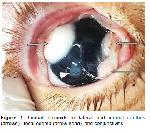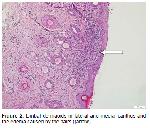 |
 |
| [ Ana Sayfa | Editörler | Danışma Kurulu | Dergi Hakkında | İçindekiler | Arşiv | Yayın Arama | Yazarlara Bilgi | E-Posta ] | |
| Fırat University Journal of Health Sciences (Veterinary) | |||||
| 2020, Cilt 34, Sayı 3, Sayfa(lar) 191-192 | |||||
| [ Özet ] [ PDF ] [ Benzer Makaleler ] [ Yazara E-Posta ] [ Editöre E-Posta ] | |||||
| Bir Buzağıda Çok Sayıda Limbal Dermoid | |||||
| Yesari ERÖKSÜZ1, İbrahim CANPOLAT2, Canan AKDENİZ İNCİLİ1, Hatice ERÖKSÜZ1 | |||||
| 1University of Fırat, Faculty of Veterinary Medicine, Department of Pathology, Elazığ, TURKEY 2University of Fırat, Faculty of Veterinary Medicine, Department of Surgery, Elazığ, TURKEY |
|||||
| Anahtar Kelimeler: Buzağı, dermoid, göz | |||||
| Özet | |||||
Simental ırkı bir buzağıda, gözün lateral ve medial kantusunda saptanan 3 adet dermoid cerrahi olarak keratektomiyle uzaklaştırıldı. Histopatolojik incelemelerde korneada substantia propria ile karışan düzensiz bir dermisin varlığı, epidermisin pigmentli çok katlı yassı epitel içerdiği, dermiste ise kistik foliküller, yağ ve ter bezleri; kıl follikülleri içerdiği saptandı. Dermiste subepitelial olarak az sayıda nötrofil, lenfosit, makrofaj ve plazma hücresinin linear infiltrasyonu mevcuttu. Çoklu korneal dermoidlerin bile yüzeysel lamellar keratektomi ile herhangi bir komplikasyon olmaksızın tedavi edilebileceği sonucuna varıldı. |
|||||
| Giriş | |||||
Corneal anomalies might be ectodermal or mesenchymal in origin affecting corneal size, shape and/or transparency 1. Dermoid is a congenital lesion which is also defined as choristoma. It is characterized by focal differentiation and overgrowth of the skin in the cornea, conjunctiva or eyelids. It is observed in all animal species reflecting histologically normal tissue in an abnormal location characterized by focal skin-like differentiation 2. They are often seen as single and spontaneous, and the exact pathogenesis is not known. It is thought to be formed defective induction (skin instead of corneal epithelium) by the invading corneal stromal mesenchyme is the most popular speculation 2,3. The aim of this report was to describe the pathology of limbal dermoids in a calf. |
|||||
| Olgu Sunusu | |||||
A 2-month-old Simmental calf was presented with an abnormal appearance in the right eye to Veterinary Teaching Hospital of Firat University. Certificate of approval was taken from animal owner There were 3 masses attached to the limbus with hairs arising from the surface (Figure 1). The masses were located on the median and lateral canthus of the cornea measuring the cornea 0.9 to 1.5 cm. There was mild epiphora, blepharospasm, focal edema and moderate conjunctivitis. No other ocular abnormalities were present in the eyes. The clinical diagnosis was limbal dermoids which was treated by superficial keratectomy after sedation and topical retrobulbar anesthesia. Lamellar dissection was accomplished without complication. For sedation, 1 mg/kg intramuscular (IM) Xylazine-HCL (Rompun 2%, Bayer, Germany) was applied. Ketamine-HCL at 10 mg/kg IM dose for general anesthesia was applied (Ketasol 10% Richter Pharma AG, Austria).
Local ophthalmic pomade applied twice daily for 2 weeks postoperatively. Ocular healing was uneventful, with prominent resolution in 2 weeks. Histopathologic examinations; replacing 30% of the cornea is sparsely pigmented, cornified, stratified squamous epithelium overlying an irregular dermis that blends with the corneal substantia propria. The dermis contained cystic follicles; nests of sebocytes, apocrine glands; hair shafts and linear subepithelial infiltrates of few neutrophils, lymphocytes, macrophages, and plasma cells. All the three samples have almost the same histological appearance (Figure 2).
|
|||||
| Tartışma | |||||
Dermoids have been reported in many breeds of cattle and can be unilateral or bilateral 1. Ocular dermoids in cattle are reported with prevalence of 0.002% 5 with the high prevalence in Hereford and Simmental bred cattle 1. Depending on the location, vision may be impaired. The dermoid tends to mix with the dermal collagen around it, and the epidermis transforms itself into the corneal epithelium. Rarely, large and single dermoid can cover the entire cornea 4 or be found bilaterally 6. In the present case, roughly 30% of the cornea was covered by the dermoid masses. The precise histogenesis and origin of ocular dermoids are unclear, however defective induction (skin instead of corneal epithelium) by the underlying epithelium and corneal stromal mesenchyma is the most popular speculation. Dermoids have many or all features of normal skin. No relation was found between vitamin A or β karoten deficiency in calves with dermoid 7. Dermoid hairs may irritate the cornea or block the vision by settling; in such cases they are removed by surgical intervention. In most cases, the corneal dermoid is associated with a normal thickness corneal stroma, and removal of the dermoid does not risk perforating the eyeball 1,3. However, some deep corneal dermoids m,ght cause scar tissue formation 6. The superficial stroma was removed with keratectomy in this case and the residual scarring was not detected in the visual axis. In the present case the long hairs growing from the dermoids irritated the cornea, causing focal edema. Limbus has a special importance in the healing of corneal injuries in terms of being the source of stem cells. The new cells that originate from here and migrate in injury site and turn into endotel cells in corneal damage. How the present surgical procedure will affect the future corneal injuries is scientific curiosity and it can only be demonstrated by experimental studies. Overall, dermoids are to be considered corneal and conjunctival masses in newborn calves before the aggressive treatment. It is concluded that even multiple limbal corneal dermoids can be treated by superficial lamellar keratectomy without any complication. |
|||||
| Kaynaklar | |||||
1) Wilcock BP, Njaa BL. Special senses. In: Maxie MG (Editors). Jubb, Kennedy, and Palmers Pathology of Domestic Animals. Vol 1, 6rd Edition, St. Louis, MO: Elsevier Limited: 2016: 475-476.
2) Dubielzig RR, Ketring KL, McLellan GJ, Albert DM. Veterinary ocular pathology, a comparative review. Philadelphia, PA:Elsevier; 2010: 123: 145, 147.
3) Labelle P. The eye. In: Zachary JF (Editors). Pathologic Basis of Veterinary Disease. 6rd Edition; St. Louis, MO: Elsevier; 2017: 1297.
4) Kiliç N, Toplu N, Epikmen ET. Surgical treatment of corneal large dermoid in a simmental calf. Acta Scientiae Veterinariae 2012; 40: 1041.
|
|||||
| [ Başa Dön ] [ Özet ] [ PDF ] [ Benzer Makaleler ] [ Yazara E-Posta ] [ Editöre E-Posta ] | |||||
 |
| [ Ana Sayfa | Editörler | Danışma Kurulu | Dergi Hakkında | İçindekiler | Arşiv | Yayın Arama | Yazarlara Bilgi | E-Posta ] |

